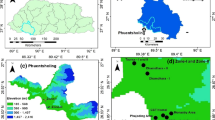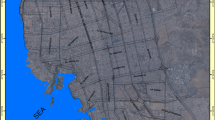Abstract
It is well known that the potential hazard during an earthquake is mainly in alluvium or alluvium filled basins; shear wave velocity plays a significant role in estimating the possible hazard during an earth quake in such an area. This paper presents shear wave velocity profile from Jabalpur, Central India mainly dominated by alluvial soil that was moderately affected by an earthquake of magnitude 6.5 in May, 1997. The acquired shear wave velocity by Multichannel Analysis of Surface Wave (MASW) in as many as 36 sites over alluvial soil ranges from 200 m/sec to 400 m/sec and in a few sites marginally less than 200 m/sec corresponding to a sub-surface depth of 30–35 m. Further, the computed N values vary as low as near zero to less than 25. The study is substantiated by the estimation of P-wave velocity by refraction seismic method at the same locations of MASW which ranges from 350 m/sec to 2200 m/sec. The results suggest that the damage during an earth quake appears to be highly unlikely in view of the marginally high Vs up to depth of 30 m. This study on seismic hazard is substantiated by the estimation of frequency of the ground as well as amplification which is found to be a maximum of about 2.5 in the frequency band of 2–6 Hz in west and north western portion of the study area.
Similar content being viewed by others
References
Andrus, R.D. and Stokoe, K.H.II. (2000) Liquefaction of Soils from Shear-Wave Velocity. Jour. Geotech. Geo-environmental Engg., ASCE, v.126(11), pp.1015–1025.
Applegate, D (2004) Opinion: stepping up to the plate. Seism. Res. Lett., v.75, pp.335–337.
Asten, M.W. and Boore, D.M. (Eds.) (2005) Blind comparisons of shearwave velocities at closely spaced sites in San Jose, California: U.S. Geological Survey Open-File Report. 2005–1169.
ASTM D4428/D4428M-00 (2005) American Society for Testing and Materials. Standard test methods for crosshole seismic testing, Annual Book of ASTM Standards 04.08, Conshohoken, Penna
Borcherdt, R., Wentworth, C.M., Janssen, A., Fumal, T. and Gibbs, J. (1991) Methodology for Predictive GIS Mapping of Special Study Zones for Strong Ground Shaking in the San Francisco Bay Region, CA, Proc. 4th Int. Conf. Seismic Zonation, pp.545–552.
BSSC (Building Seismic Safety Council) (1998) 1997 Edition NEHRP recommended Provisions for Seismic Regulations for New Buildings, FEMA 302/303, developed for the Federal Emergency Management Agency, Washington, D.C.
Cramer, C.H. (2003) Site-specific seismic hazard analysis that is completely probabilistic, Bull. Seismol. Soc. Amer., v.93, pp.1841–1846.
Cramer, C.H., Gomberg, J.S., Schweig, E.S., Waldron, B.A. and Tucker, K., (2004) The Memphis, Shelby County, Tennessee Seismic Hazard Maps, U.S. Geological Survey Open-File Report. 04–1294.
Federal Emergency Management Agency (FEMA), (1997) Multi Hazard Identification and Assessment. FEMA. Washington, D.C.
Field, E.H., and the SCEC Phase III Working Group (2000) Accounting for site effects in probabilistic seismic hazard analyses of southern California: Overview of the SCEC Phase III Report. Bull. Seism. Soc. Amer., v.90:6B, pp.S1-S31.
Finn, W.D. Liam, 1991, Geotechnical Engineering Aspects of Microzonation; Proceedings of the Fourth International Conference on Seismic Zonation, Stanford, California, Volume I, pp.199–259.
Ganev, T., yamazaki F., Ishizaki H., and Kipazawa M. (2000) earthquake response of the Higashi-Kobe Bridge, INCEDE report 15.
Ghose, R., and Goudswaard, J.,(2004) Integrating S-wave seismic reflection data and cone penetration test, CPT, data using a multi angle multi scale approach. Geophysics, v.69, pp.440–459.
Gupta, H.K., (1999), India: Major Earthquake related events in India between two WSSI Workshops at Bangkok, Second WSSI Bangkok Workshop on Seismic Risk Management.
International Conference of Building Officials (ICBO), (1997), 1997 Uniform Building Code (1997-UBC), Whittier/CA, United States of America, p.492.
Kramer, S.L. (1996) Geotechnical Earthquake Engineering, Prentice-Hall, Upper Saddle River, New Jersey.
NEHRP, (1997), NEHRP Recommended Provisions for Seismic Regulations for New Buildings and Other Structures, Part 1: Provisions, Building Seismic Safety Council, Washington, D.C.
Park, C.B., Xia, J., and Miller, R.D. (1998) Imaging dispersion curves of surface waves on multi-channel record: 68th Ann. Internat. Mtg., Soc. Expl. Geophys., Expanded Abstracts, pp.1377–1380.
Park, C.B., Miller, R.D. and Xia, J. (1999) Multi-channel analysis of surface waves. Geophysics, v.64, pp.800–808.
Richart, F.E., Hall, J.R. and Woods, R.D. (1970) Vibrations of soils and foundations: Prentice-Hall, Inc.
Seshunarayana, T. and Sundarrajan, N. (2012) Determination of shear wave velocity and depth to basement using multichannel analysis of surface wave technique: Jour. Geol. Soc. India, v.89, pp.499–504.
Sundararajan, N. and Seshunarayana, T. (2011) Liquefaction hazard assessment of earthquake prone area: a case study based on shear wave velocity by multichannel analysis of surface waves (MASW). Geotech Geol. Engg., v.29, pp.267–27.
Tiwari, M.P. and Bhai, H.Y. (1997) Quarternary stratigraphy of the Narmada valley. Geol. Surv. India, Spec. Publ., no.46, pp.33–63.
Trupti, S., Goverdhan, K., Srinivas, K.K.N.S.S., Prasad, P.P. and Seshunarayana, T. (2013) Site classification of Pondicherry using shearwave velocity and horizontal-to-vertical spectral ratio. Natural Hazards, v.69, pp.953–964.
Turnbull, M.L. (2001) Seismic hazard assessment and microzonation of Bandaberg. Masters thesis, Central Queensland University, Australia
Venkataraman, N.V., Mishra, P.S., Tiwari, M., Soni, M.K. and Roy, A. (2000) Geotectonic setting and seismicity of the area in Jabalpur Earthquake, 22nd May, 1997: A Geoscientific Study. Geol. Surv. India, Spec. Publ., no.51, pp.1–18.
Author information
Authors and Affiliations
Corresponding author
Rights and permissions
About this article
Cite this article
Sundararajan, N., Seshunarayana, T. Shear Wave Velocities in the Estimation of Earthquake Hazard Over Alluvium in Seismically Active Region. J Geol Soc India 92, 259–264 (2018). https://doi.org/10.1007/s12594-018-1002-y
Received:
Accepted:
Published:
Issue Date:
DOI: https://doi.org/10.1007/s12594-018-1002-y




